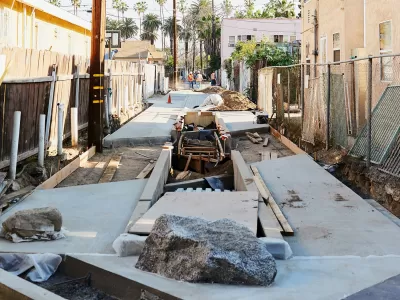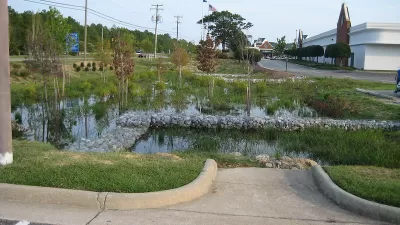Rather than shuttling stormwater away from the city and into the ocean as quickly as possible, Los Angeles is now—slowly—moving toward a ‘city-as-sponge’ approach that would capture and reclaim more water to recharge crucial reservoirs.

A program that installed green infrastructure in Los Angeles alleyways got its first real test last month as massive storms pummeled the region, bringing rain that overwhelmed much of Southern California’s stormwater infrastructure. As Alissa Walker writes in Curbed, thanks to the “green alleys” installed as part of a 2015 project in South Los Angeles, “the resulting stormwater had more opportunities to sink back into the earth: filtering through a row of permeable pavers, directing to pocket planters where creeping fig vines twirl up garage walls, or vanishing into grates labeled ‘drains to groundwater.’”
Walker explains that “a single green alley is able to capture enough stormwater per year to store it in dry wells below the pavers where it can slowly percolate into the groundwater, says Allen Compton, founder of the landscape architecture firm SALT, which designed these alleys.” The alleys connect to the South L.A. Wetlands Park, another key piece of green infrastructure that collects stormwater and provides habitat for local wildlife.
As storms become more intense and unpredictable, paved-over cities like Los Angeles can use permeable materials and sustainable design elements to capture and reclaim stormwater more effectively, recharge groundwater reserves, and prevent damaging floods. But “Because stormwater is still erroneously classified as a waste product, its management is handled by the same department that picks up the trash,” while other efforts are scattered across city and county agencies. According to Walker, Los Angeles is developing an interagency stormwater plan that would streamline and coordinate stormwater management efforts.
FULL STORY: L.A.’s ‘Green Alley’ Experiments Are Working”

Trump Administration Could Effectively End Housing Voucher Program
Federal officials are eyeing major cuts to the Section 8 program that helps millions of low-income households pay rent.

Planetizen Federal Action Tracker
A weekly monitor of how Trump’s orders and actions are impacting planners and planning in America.

Ken Jennings Launches Transit Web Series
The Jeopardy champ wants you to ride public transit.

Opinion: Transit Agencies Must View Service Cuts as Last Resort
Reducing service could cripple transit systems by pushing more riders to consider car ownership, making future recovery even less certain.

‘Smart Surfaces’ Policy Guide Offers Advice for Building and Maintaining Urban Tree Canopies
Healthy, robust tree canopies can reduce the impacts of extreme heat and improve air quality.

New Jersey Lawsuit Targets Rent-Setting Algorithms
The state of New Jersey is taking legal action against landlords and companies that engage in what the state’s Attorney General alleges is illegal rent fixing.
Urban Design for Planners 1: Software Tools
This six-course series explores essential urban design concepts using open source software and equips planners with the tools they need to participate fully in the urban design process.
Planning for Universal Design
Learn the tools for implementing Universal Design in planning regulations.
Heyer Gruel & Associates PA
Ada County Highway District
Institute for Housing and Urban Development Studies (IHS)
City of Grandview
Harvard GSD Executive Education
Toledo-Lucas County Plan Commissions
Salt Lake City
NYU Wagner Graduate School of Public Service



























